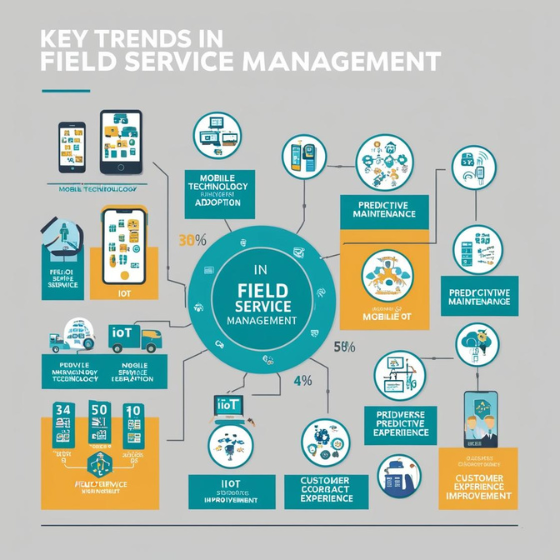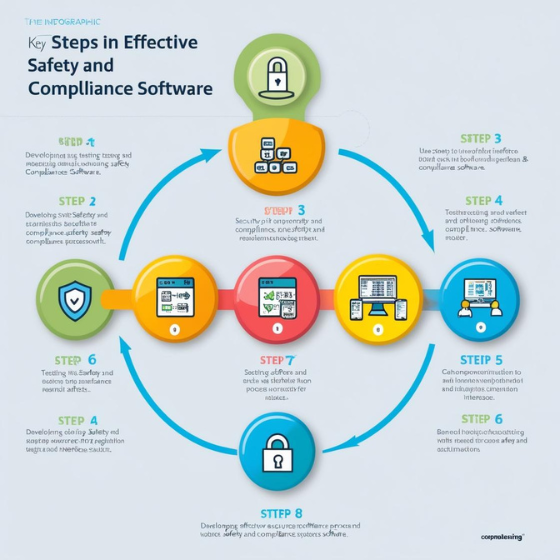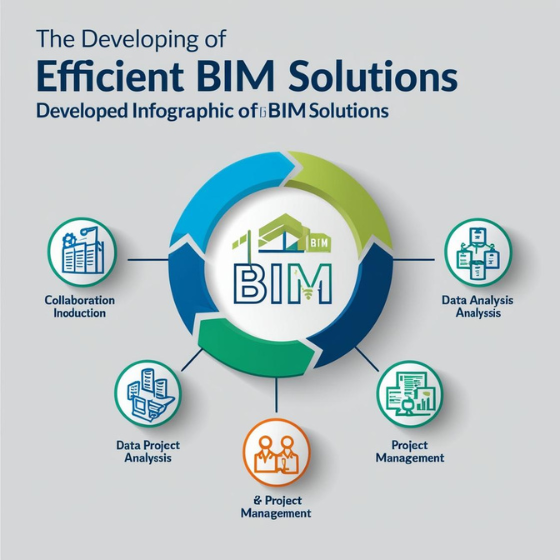Key Trends in Field Service Management
The field service industry is evolving rapidly, driven by technological advancements, shifting customer expectations, and the need for more efficient operations. To stay competitive, businesses must stay informed about emerging trends that shape the future of Field Service Management (FSM).
In this blog, we’ll explore the key trends in field service management, highlighting how they’re transforming on-site operations and boosting efficiency.
Why Staying Ahead of FSM Trends Matters
Field service companies face increasing pressure to deliver faster, more reliable, and customer-centric services. By adopting the latest trends, businesses can:
- Enhance operational efficiency.
- Reduce costs and downtime.
- Meet rising customer expectations.
- Gain a competitive edge in a saturated market.
Let’s dive into the key trends revolutionizing field service management.
Key Trends in Field Service Management
1. AI-Driven Automation
Artificial Intelligence (AI) is becoming a cornerstone of FSM, automating repetitive tasks and enhancing decision-making. AI enables:
- Predictive Scheduling: Automating task assignments based on real-time data, technician availability, and customer preferences.
- Chatbots: Providing 24/7 customer support for common queries.
- Demand Forecasting: Analyzing historical data to predict service demand and allocate resources efficiently.
Example: An HVAC company reduced response times by 40% by implementing AI-based dispatching.
2. Mobile-First FSM Solutions
Mobile accessibility is no longer optional—it’s a necessity for technicians working on-site. Mobile FSM apps allow technicians to:
- Access job details, schedules, and customer history on the go.
- Upload photos, reports, and service updates in real-time.
- Communicate seamlessly with managers and customers.
Mobile-first solutions ensure that technicians are always connected and informed, even in remote locations.
3. IoT-Enabled Field Service
The Internet of Things (IoT) is transforming FSM by enabling connected devices to communicate in real-time. IoT empowers businesses to:
- Predict Equipment Failures: IoT sensors monitor equipment and alert technicians about potential issues before breakdowns occur.
- Automate Maintenance Scheduling: Automatically schedule maintenance based on usage patterns and sensor data.
- Reduce Downtime: Address problems proactively, minimizing disruptions.
Example: IoT integration helped a manufacturing company reduce equipment downtime by 25%, resulting in significant cost savings.
4. Augmented Reality (AR) and Virtual Reality (VR)
AR and VR technologies are revolutionizing how technicians approach on-site tasks by providing immersive, interactive experiences. These technologies enable:
- Remote Assistance: AR tools allow technicians to receive step-by-step guidance from experts, reducing the need for repeat visits.
- Hands-Free Troubleshooting: Wearable AR devices provide instructions while keeping technicians’ hands free.
- Training Simulations: VR offers realistic training scenarios to prepare technicians for complex tasks.
Pro Tip: Incorporating AR tools can improve first-time fix rates and reduce service times.
5. Customer-Centric Service Models
Modern customers expect personalized, transparent, and proactive services. FSM systems are adopting customer-focused features such as:
- Real-Time Updates: Live tracking of technician locations and estimated arrival times.
- Self-Service Portals: Allowing customers to schedule appointments, track service requests, and provide feedback.
- Proactive Notifications: Sending alerts about maintenance needs or delays.
Stat: Studies show that 73% of customers are more likely to remain loyal to a brand that offers proactive and personalized service.
6. Data-Driven Decision-Making
Advanced analytics tools are helping FSM companies make data-driven decisions to optimize operations and improve service quality. Analytics enable:
- Performance Monitoring: Tracking key metrics like first-time fix rates and technician productivity.
- Risk Assessment: Identifying potential bottlenecks or inefficiencies.
- Customer Insights: Analyzing feedback to refine services and enhance satisfaction.
Example: A field service company used analytics to improve technician allocation, reducing overtime costs by 15%.
7. Cloud-Based FSM Platforms
Cloud-based systems are becoming the norm in FSM due to their flexibility, scalability, and cost-efficiency. Benefits include:
- Anywhere Access: Field teams and managers can access data from any device with an internet connection.
- Real-Time Collaboration: Ensures seamless communication between on-site and back-office teams.
- Automatic Updates: Cloud platforms are easier to update and scale as business needs grow.
Cloud technology ensures that businesses remain agile and responsive in a fast-changing market.
8. Sustainability and Green Practices
With growing environmental awareness, FSM companies are focusing on sustainability. Practices include:
- Optimized Routing: Reducing fuel consumption with AI-driven route optimization.
- Energy-Efficient Tools: Using equipment and vehicles with lower energy footprints.
- Paperless Operations: Digitizing workflows to minimize waste.
Pro Tip: Highlighting sustainable practices can boost brand reputation and appeal to environmentally conscious customers.
9. Employee Empowerment Through Technology
Empowering technicians is critical for successful FSM operations. Modern FSM systems include features that:
- Simplify daily workflows with automated scheduling and inventory tracking.
- Provide real-time access to training materials and troubleshooting guides.
- Offer performance dashboards to track progress and set personal goals.
Investing in user-friendly tools leads to more engaged and productive field teams.
10. Subscription-Based Service Models
Many FSM companies are transitioning to subscription-based service models to provide consistent revenue streams and build stronger customer relationships. These models include:
- Regular Maintenance Plans: Offering scheduled services at fixed intervals.
- Proactive Monitoring Services: Using IoT to monitor equipment and offer predictive maintenance.
- Flexible Subscription Packages: Allowing customers to choose plans based on their specific needs.
This trend aligns with customers’ preference for predictable costs and proactive service.
Why Partner with Sodio for FSM Solutions?
At Sodio, we’re at the forefront of FSM innovation, helping businesses harness these trends to optimize their operations. Here’s why Sodio is your ideal partner:
- Custom Solutions: We design FSM systems tailored to your industry’s unique challenges and goals.
- Scalable Platforms: Our solutions grow with your business, ensuring long-term value.
- Cutting-Edge Features: From IoT integration to mobile-first designs, we incorporate the latest trends to future-proof your operations.
- Customer-Centric Design: We prioritize intuitive interfaces and personalized features to enhance the user experience.
Final Thoughts
Field Service Management is evolving rapidly, with trends like AI, IoT, and AR shaping its future. By embracing these innovations, businesses can streamline operations, improve customer satisfaction, and stay ahead of the competition.
Are you ready to modernize your field service operations? Contact Sodio today to learn more about our custom FSM solutions and start your journey toward on-site efficiency and excellence.







